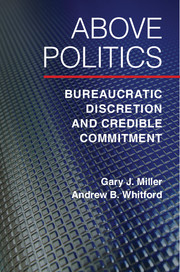Book contents
- Frontmatter
- Contents
- Preface
- Acknowledgments
- 1 Introduction
- 2 The Moral Hazard of Bureaucrats and Politicians
- 3 Political Moral Hazard and Credible Commitment
- 4 Political Moral Hazard and Bureaucratic Autonomy
- 5 “Above Politics”: The Separation of Powers and Bureaucratic Autonomy
- 6 The Control Paradox, Trust, and Leadership
- 7 Professionalism and Credible Commitment
- 8 The Politicization of Financial Regulation
- 9 The Financial Crisis and Reregulation
- 10 Conclusion: The Unraveling of Dodd-Frank
- Works Cited
- Index
- Other books in the series (Series List Continued from page ii)
9 - The Financial Crisis and Reregulation
Published online by Cambridge University Press: 05 May 2016
- Frontmatter
- Contents
- Preface
- Acknowledgments
- 1 Introduction
- 2 The Moral Hazard of Bureaucrats and Politicians
- 3 Political Moral Hazard and Credible Commitment
- 4 Political Moral Hazard and Bureaucratic Autonomy
- 5 “Above Politics”: The Separation of Powers and Bureaucratic Autonomy
- 6 The Control Paradox, Trust, and Leadership
- 7 Professionalism and Credible Commitment
- 8 The Politicization of Financial Regulation
- 9 The Financial Crisis and Reregulation
- 10 Conclusion: The Unraveling of Dodd-Frank
- Works Cited
- Index
- Other books in the series (Series List Continued from page ii)
Summary
The only case for an independent central bank in a democracy is that it can take a longer-term view and do what is in the interest of the people in ways that elected politicians cannot.
– Wessel (2009, 271)“It's laissez faire until you get in deep shit”
– Gutfreund quoted in M. Lewis (2010, 264)MERRILL LYNCH
Merrill Lynch was a financial firm known for its “thundering herd” of brokers – a herd of up to 15,000 brokers that made Merrill Lynch the brokerage firm for the general public. These brokers allowed Merrill Lynch to sell directly to the public the stock offerings that it underwrote. As an organization, it also had a strong “family-style” culture that helped keep its large work force motivated and loyal.
As the largest brokerage, it could also make risk-free money through financial advice and commissions. Unfortunately, when it did take risk, it generally seemed to fail. It had gambled on trader Howie Rubin and almost went broke when Rubin lost hundreds of millions of dollars on mortgage bonds (Gasparino, 2009, 177). It convinced Orange County to buy mortgage bonds in 1994, and Orange County went bankrupt. It lost more hundreds of millions with the failure of Long Term Capital Management (LTCM), the elite firm that relied on Nobel Prize-winning economists, mathematical models, and a lot of leverage. “In all of these cases, the firm's response was to drastically scale back on risk and miss out on the subsequent bond market rally, only to get back into the market near its top, when the bubble was about to burst once again” (177).
By 2003, Merrill Lynch still had a family-style culture, and it had one of the lowest leverage rates on Wall Street, with just $16 in borrowed funds for every dollar of its own (Gasparino, 2009, 178). In that year, however, change came to Merrill Lynch in the form of Stanley O'Neal, CEO and chair. O'Neal set out to transform Merrill Lynch into another Goldman Sachs, complete with a large trading desk of its own, a willingness to take big risks in pursuit of high-reward investments, and a greatly expanded leverage rate. To do this, O'Neal fired a large number of employees, and instilled a much more hard-driving, competitive culture. His rule was increasingly autocratic; he made it clear that he did not want to hear dissenting opinions.
- Type
- Chapter
- Information
- Above PoliticsBureaucratic Discretion and Credible Commitment, pp. 201 - 219Publisher: Cambridge University PressPrint publication year: 2016



